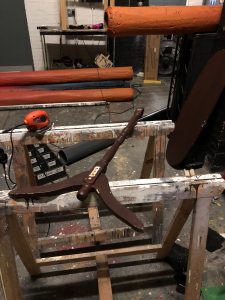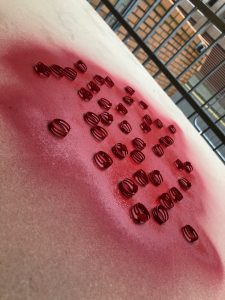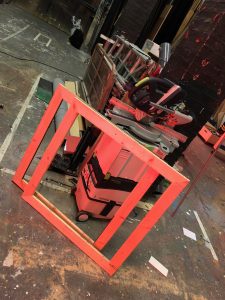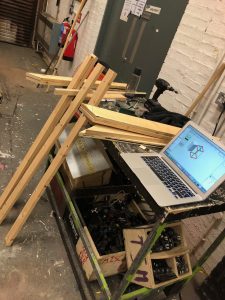Having attended two final design meetings and a couple of actor/technician meet-and-greets towards the end of last year, I had a basic understanding going into this allocation of what the two Shakespeare shows would look like and how complex they were likely going to end up being. What became the main question upon actually starting work on the shows, however, was ‘what is there actually left to do?’ As both shows had received the luxury of ‘rehearsal ASMs’ in the run-up to Christmas, there was very little of the initial props sourcing left to do, with some small makes and alterations forming the main portion of the work prior to tech.
My first week was spent working on Twelfth Night with Riona as my Stage Manager. As this show was very prop-heavy there were still quite a few items to be worked on, with the morning session of my first day comprising of spray painting and glueing together 40 red jewelled rings which would be hung around the space, as well as being used by the company as personal props. Once these were completed, we spent some time in the rehearsal room and props store dealing with the back-log of rehearsal noted items that the director wanted time to work with, but which hadn’t been sourced yet, along with taking a large mirror from the store to Renfrew Street to work on. It was rickety and falling apart, so the first stage of the project became deconstructing the piece to its component parts, sanding, and filling it back to a good enough standard to work with. After painting every component to the Designer’s requested finish – a gold which still adorns the front of one of my black hoodies – I reassembled it with the appropriate bolts and screws, replacing the broken or too short ones I had taken out. Now complete, this was returned to the rehearsal room and was another tick off our to-do list.


Left: The Dissassembled Mirror, Sanded and Prepped for Paint
Right: 40 Rings, Spray Painted Red and Waiting for Jewels
That to-do list – as a side note – was a document which didn’t actually exist until midway through that week. Upon completion of every task I was set, it always surprised me that we didn’t have an overall tick list of tasks to complete, and were pulling our inspiration for jobs from several different bits of paper, post-it notes, rehearsal emails, and memory. I suggested that we either use some of the whiteboard in the office, or more easily create a Wunderlist page to fix this issue and, after doing both of these, I found that our workload sped up considerably; our new lists acting as great motivation techniques.
Alongside my ASM duties, I had been asked by the TSM of the show to construct a cover which could live in the void between catwalks two and three during the show and hide the mirror ball when not in use. Though this looked like an easy task from the outset, there were quite a few hidden challenges upon further thought. Firstly, the mirror ball which we would be using was massive. Unlike the 300mm diameter ones usually used in the Chandler this unit was 600mm across, and when combined with its chain and motor measured 1200mm from top to bottom. As the catwalks are not that tall, I reasoned that the box I built would have to sit above the standard catwalk to catwalk crossbars, and would, therefore, require a top bar built in that could house the pulley and flying mechanism to allow the ball to come in and out – as there would be no other way of getting a point that high up. With all of these things in mind, I drew up a plan and set about constructing this ‘Box of Death’, skinning it with tatt and installing half couplers on either side so that it could support itself on crossbars by the side. With a bit of packing and paint, this beast was complete and would be fitted-up with the LX rig when the show reached the venue.


Cutting and Assembling the ‘Box of Death’
Another one of the main tasks we had to complete during the week I prepped this show was the sourcing and purchasing of the food that would be served to the audience during the party scene. Due to the tight nature of our budget – most of which was gone by the time I began working on the show – we resorted to asking supermarkets for charitable donations, though the specificity of our food needs made this challenging. The entirety of one day was spent making phone calls to supermarkets, with Riona searching Customer Services numbers that I could then phone up. Though this was not, I feel, a useful division of time, we managed to contact enough supermarkets that one finally decided to provide what we asked for, with Riona deciding she would go and pick them up the following week whilst I was in tech for Caesar. This happened to also be the day when the main building’s power failed, made even more annoying by the fact that all the items we needed to spend time working on were locked inside. Losing a day wasn’t fun – especially with so much left to do.
As this week progressed, and as I spent more and more time working with her, a horrible realisation began to form about how myself and my Stage Manager worked together. I don’t know why myself and my HOD never really clicked. I endeavoured, wherever possible, to be professional in my attitude, completing any task I was set as quickly and efficiently as I could, and always proactively asking what we could work on next – something I would expect anyone working with me to do if I had had the to-do list in my hand. But from making every job that we had to complete a ‘Together Task’ – meaning I was constantly under supervision and scrutiny – to roaming Glasgow City Centre carrying bags of lemonade because ‘It’s nice to have a guy to carry the heavy stuff’, I didn’t feel particularly respected or that my applicable skills were being valued. I was made to feel like an assistant of the Stage Manager, rather than an ASM. Now, I grant that this would be fine if this was just the way my H.O.D. chose to work. The allocation is not that long, and I can find ways to work around different management styles I may disagree with; with experiences like CPP and ‘Chess’ last year teaching me how to work better with other people to avoid clashes. But this working environment was unpleasant and unprofessional, and I felt dragged into needless drama that would never have become an issue if she had been more prepared to deal with situations that any SM has to go through – from bitching about the director to me once his back was turned after he asked her for more rehearsal props in the room, to asking whether the DSM was ‘this much of a cold-hearted bitch in real life’ after receiving one pointed email too many. I felt uncomfortable, and that I was forced to take sides in a division that should never have existed in the same team.
Finding positives to take out of this, however, I would say I have a greater appreciation for the importance of a team that sticks together and stick by each other. Though the idea of collective responsibility has the possibility to backfire, I’d say that keeping and dealing with professional differences between the parties involved, rather than outsource to another member of the team in hopes of getting them on side is the right attitude to have. I didn’t want to – and did not – pick sides; it would have compromised my ability to do the job. As a future HOD, I would seek to work out issues like this when they first developed, and find ways of working with challenging individuals before it got to a point where it started to damage the show. Many of the issues that arose from this show were due to a lack of communication and co-operation and has more than clearly demonstrated the dangers that can result from that happening, and the impact it can have on the success of the piece.

